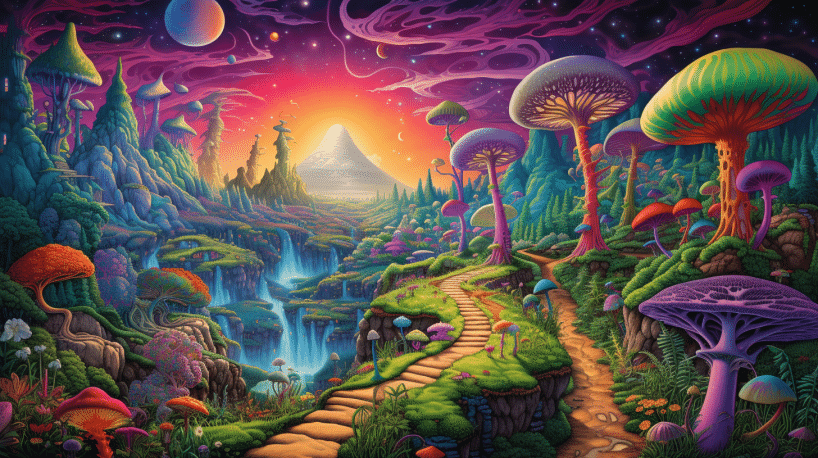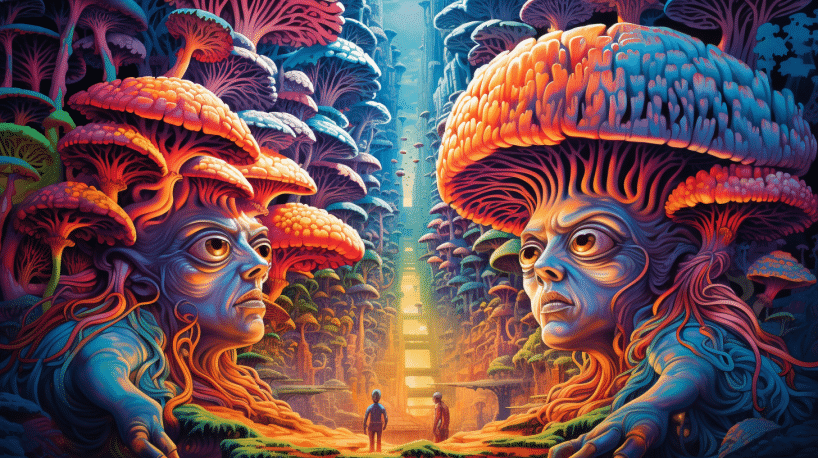Researchers have discovered that classic psychedelic drugs like LSD and psilocybin (‘magic mushrooms’) flatten the energy landscape of the brain.
This effect makes it easier for the brain to transition between different states of activity and leads to more diverse and entropic neural dynamics overall.
Key Facts:
- Using fMRI data and network modeling, researchers found psychedelics reduce the control energy needed for the brain to switch between recurrent activity patterns.
- Flatter energy landscapes were associated with more frequent state transitions and more complex neural sequences in individuals.
- The serotonin 2a receptor spatial distribution was found to be uniquely capable of flattening the landscape over other serotonin receptors.
Source: Nature Communications. 2022; 13: 5812.
The Psychedelic Experience & Brain Entropy
Psychedelics like LSD and psilocybin are known change consciousness dramatically, inducing altered perceptions, emotions, and subjective experiences.
These unique subjective effects are believed to arise from the way these serotonergic compounds modify activity across the brain.
Specifically, psychedelics have been shown to increase the entropy – the complexity and diversity – of spontaneous brain signals.
The Entropic Brain Hypothesis proposes that by increasing neural entropy, psychedelics expand the richness of conscious content that one can experience.
But how do these drugs increase brain entropy on a mechanistic level?
Researchers hypothesized this effect may arise from psychedelics “flattening” the energy landscape of the brain.
Mapping the Brain’s Energy Landscape
The brain dynamically switches between different states of coordinated activity, even at rest.
The energy landscape refers to the barriers or effort required for the brain to transition between these different states or modes of activity.
Using network control theory, researchers can map this landscape by calculating the minimum input energy required to change the brain’s activity from one state to another.
The energy values provide an objective measure of how effortful or “costly” state transitions are.
Psychedelics Flatten the Landscape, Making State Changes Easier
Analyzing fMRI data, researchers found that psychedelics significantly reduced the control energy required to transition between all pairs of the brain’s reoccurring activity states compared to placebo conditions.
This demonstrates that psychedelics appear to flatten the energy landscape of the brain, reducing the barriers between states and making transitions more facile.
Flatter Landscapes Relate to More Diverse Neural Dynamics
The researchers also found that the degree of flattening induced by LSD correlated with individual increases in state transition frequency and sequence complexity under the drug.

This provides evidence that the flattened control landscape translates to more dynamic neural activity, supporting the link between easier state transitions and greater entropy.
The Serotonin 2a Receptor Enables the Flattening Effect
Since psychedelics like LSD and psilocybin exert their primary effects via the serotonin 2a receptor (5-HT2a), the researchers hypothesized this receptor system may enable the landscape flattening effect.
Using PET imaging data, they found that incorporating the specific spatial distribution of 5-HT2a receptors into their model greatly flattened the control energy landscape, mirroring the effect seen empirically under psychedelics.
This suggests the localization of the 5-HT2a receptors is optimized to allow for broader exploration of the brain’s activity space when activated.
No other serotonin receptor maps tested had the same flattening capability.
Implications of the Psychedelic ‘Flattened’ Brain
This groundbreaking study provides support for the theory that psychedelics relax the constraints on the brain’s activity dynamics through a flattening of the energy landscape that enables more facile transitions between states.
By linking subjective phenomenology, entropy, landscape topography, and receptor pharmacology, the work moves us closer to a unified mechanistic understanding of the psychedelic state.
The findings help explain how psychedelics give rise to more flexible and entropic functional connections between brain networks, breaking down their rigid infrastructure.
This lawlessness and reduced resistance to change is thought to underlie the therapeutic benefits of psychedelics.
With further research, this novel receptor-based modeling approach could be useful for mapping how different neuromodulatory compounds impact the navigability of the neural state space in health and disease.
Detailed Summary of the Study and Findings
Brain Imaging and Drug Studies
The researchers analyzed functional MRI (fMRI) data from two previous studies that compared either LSD or psilocybin to placebo in healthy volunteers.
The LSD study had 15 subjects receive 75ug LSD infusion versus saline placebo across two blinded sessions. Scans were done at the peak drug effects (~2 hours after infusion).
The psilocybin study had 9 subjects receive 2mg psilocybin injection versus saline placebo across two blinded sessions. Scans were done immediately after injection as the drug took effect.
Identifying Recurrent Brain State Patterns
From the fMRI data, the team used k-means clustering to group the temporal brain activity patterns into a set of recurring states, labeled MS-1a, MS-1b, MS-2a, and MS-2b.
MS-1 and MS-2 represented two larger “meta-states”, each composed of an opposing pair of sub-states. MS-1 linked the somatomotor network with the salience network, while MS-2 linked the default mode network with the frontoparietal control network.
Psychedelics Shift Time Spent Between States
Under LSD, subjects spent more time in the MS-1 states, and less time in the MS-2 states compared to placebo.
Psilocybin induced shifts in the same direction, although not as robustly, possibly due to the shorter scans or the drug being in its onset phase.
Control Energy Landscape Analysis
Leveraging network control theory, the researchers then calculated the minimum input energy required to transition between each brain state.
This modeling revealed that LSD and psilocybin significantly reduced the transition energy needed between all state pairs compared to placebo.
5-HT2a Receptors Optimize the Flattening Effect
Next, using PET imaging data, the team generated a map of 5-HT2a receptor densities across brain regions.
Incorporating this 5-HT2a map into the energy calculation on placebo fMRI data greatly reduced control energies, mirroring the reductions seen under psychedelics.
The 5-HT2a receptor map flattened the landscape significantly more than spatial maps of other serotonin receptors. This confirms the specific role of 5-HT2a receptors in enabling the psychedelics’ flattening effect on the brain’s energy landscape.
Flatter Landscapes Relate to More Diverse Dynamics
Finally, the researchers tested whether the degree of energy landscape flattening correlated with changes in individuals’ neural dynamics under LSD.
They found that larger LSD-induced reductions in control energy predicted more frequent state switching, shorter dwell times in states, and increased complexity of the sequence of meta-states during the drug.
This supports the relationship between the flattened energy landscape and more facile, entropic neural dynamics.
Conclusions
By integrating receptor biology, network control theory, and neuroimaging data, this innovative study advances our understanding of how psychedelics alter brain function and dynamics through 5-HT2a agonism.
The modeling platform and insights provided could eventually be used to map how different drugs modulate the navigability of brain state spaces in health and disease.
References
- Study: Receptor-informed-network control theory links LSD and psilocybin to a flattening of the brain’s control energy landscape
- Authors: S. Parker Singleton et al. (2022)







